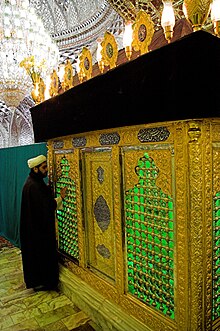mullah

Mullah or mulla, more rarely Mollah , formerly also Molla ( Arabic ملا mullā , Persian ملا Mollā , Turkish molla ; derived from Arabic مولى maulā 'Lord, Judge, Master') is an honorary title of an Islamic lawyer and religious scholar. The mullah has the status of a scholar without a state diploma and is bound to the recognition of other scholars. The <h> in the variants Mullah and Mollah is unetymological .
Generic term
In the past, the mullah was the only one in rural areas who could read and write, and thus an important social link. Up until the 20th century, the term was used for lower-ranking clergymen whose competence lay more in telling the passion stories about Ashura and not in teaching or issuing Islamic legal opinions. Today, the term “mullah” includes all Shiite clergymen , as well as prayer leaders , Friday preachers and students (Talib). Important religious legal scholars who have completed theological training are also referred to as mujtahid . Their religious titles are divided into:
- Saghatoleslam , also Saghat-ol-islam (confidante of Islam),
- Hodschatoleslam , also Hodjat-ol-islam (proof of Islam),
- Hodschatoleslam val muslimin, also Hodjat-ol-islam val muslemin (proof of Islam and the Muslims),
- Ayatollah (sign of God),
- Ayatollah al-Ozma or Grand Ayatollah (greatest sign of God) and
- Marjaʿ-e Taghlid (absolute authority / source of imitation), the highest title of the Shiite clergy. Most recently he found general recognition in the person of Ayatollah al-Ozma Borudscherdi († 1961).
Number (Iran)
In 2004, Buchta put the number of clergymen (mullah) in Iran:
- 14 Grand Ayatollah
- 5,000 Ayatollah
- 28,000 hodschatoleslam
- 180,000 simple clergymen (singers, prayer leaders, preachers, Friday preachers )
In 1977 , according to the State Minister for Religious Foundations, there were only 85,000 mullahs in Iran . The country's population grew at a similar rate during this period.
Negative connotation
As early as 1900, Mohammed Abdullah Hassan was known in English as "mad mullah". In 1979, with the Islamic revolution and the overthrow in Iran , recently reinforced by the Iranian nuclear program , the expression “crazy mullahs” or “mullah regime” is used in the western media for the political system of Iran . However, the number of mullahs operating in Iran's system of government is relatively small. In Iran, too, the word mullah is used by secular Iranians as a devaluation of clergy. The expression Achund (آخوند) is also popularly used instead of mullah.
See also
literature
- Wilfried Buchta: Shiites . Hugendubel, Munich et al. 2004, ISBN 3-7205-2491-4 , ( Diederichs Kompakt ).
- Reza Hajatpour: The burning taste of freedom. My life as a young mullah in Iran. Suhrkamp, Frankfurt am Main 2005, ISBN 3-518-12409-9 , ( Edition Suhrkamp 2409).
- Heinz Halm : The Schia . Scientific Book Society, Darmstadt 1988, ISBN 3-534-03136-9 .
- Moojan Momen: An Introduction to Shi'i Islam. The History and Doctrines of twelver Shi'ism . Yale University Press, New Haven CT et al. 1985, ISBN 0-300-03499-7 , p. 203.
- Roy Mottadeh: The Prophet's Mantle or The Life of a Persian Mullah between Religion and Politics . 2nd Edition. Beck, Munich 1988, ISBN 3-406-32289-1 .
Web links
Individual evidence
- ^ Karl Lokotsch : Etymological dictionary of the European (Germanic, Romanic and Slavic) words of oriental origin . Carl Winter, Heidelberg 1927; 2nd, unchanged edition 1975 (= Indo-European Library , 2), ISBN 353302427X , p. 115 ("Mohammedan clergyman or teacher", "higher judge in Islamic countries", in India "schoolmaster").
- ↑ see Duden , see duden.de, accessed on December 19, 2012.
- ↑ Gudrun Krämer : History of Islam. dtv-Verlag 2008, ISBN 978-3-423-34467-8 , p. 242.
- ^ Moojan Momen: Introduction to Shi'i Islam. Yale University Press, 1987, p. 234.
- ↑ See Spiegel , Das Handelsblatt , Zeit.de, accessed on December 19, 2012.
- ↑ cf. Buchta describes 5000 bearers of the title Ayatollah in Iran, only 80 of them in official state offices.
- ^ Momen, Moojan, An Introduction to Shi'i Islam , Yale University Press, 1985, p. 203.
- ↑ Glossary. In: Siba Shakib : Eskandar. (C. Bertelsmann, Munich 2009) Paperback edition, Wilhelm Goldmann, Munich 2011, pp. 595–597; here: p. 595